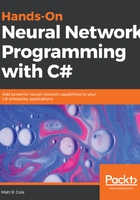
Our neural network
Let's begin by showing you an of what a simple neural network would look like, visually. It consists of an input layer with 2 inputs, a Hidden Layer with 3 neurons (sometimes called nodes), and a final output layer consisting of a single neuron. Of course, neural networks can consist of many more layers (and neurons per layer), and once you get into deep learning you will see much more of this, but for now this will suffice. Remember, each node, which is labeled as follows with an N, is an individual neuron – its own little processing brain, if you will:

Let’s break down the neural network into its three basic parts; inputs, Hidden Layers and outputs:
Inputs: This is the initial data for our network. Each input is a whose output to the Hidden Layer is the initial input value.
Hidden Layers: These are the heart and soul of our network, and all the magic happens. Neurons in this layer are assigned weights for each of their inputs. These weights start off randomized, and are adjusted as the network is trained so that the neuron's output is closer to the expected result (if we are lucky).
Outputs: These are the output our network arrives at after it performs its calculations. The output in our simple case will be either true or false, on or off. The neurons are assigned a weight for each of their inputs, which comes from the previous Hidden Layer. Although it is typically common for there to be only a single output neuron, there's absolutely nothing preventing you from having more, should you need or want more than one.